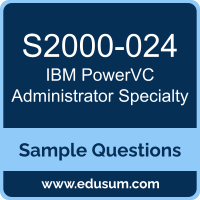01. How and when are compute templates used?
a) Used when deploying an image to select the host system on which the VM will be created
b) Used automatically when capturing a VM image so VMs created while deploying have identical configurations
c) Used when deploying an image to determine the CPU and memory resources that will be configured for the VM
d) Used automatically when deleting a VM so that the VM can be recreated with an identical configuration if needed
02. What is purpose of the powervc-register command?
a) Registers new projects in PowerVC
b) Registers users or groups in PowerVC
c) Registers a newly added Fibre Channel tape driver in PowerVC
d) Registers an OpenStack supported storage provider or fabric
03. In PowerVC, how can administrators and project managers see the current resource usage information by project?
a) Exporting data from the Storage Manager
b) Viewing the PowerVC GUI Overview page
c) Accessing the Network Controller dashboard
d) Running the powervc-resource-usage CLI command
04. Which PowerVC compute templates are provided by default?
a) tiny, small, medium, large, xlarge, xxlarge
b) light, medium, heavy, xheavy, xxheavy
c) standalone, cluster, resilient, mirrored
d) none, it is necessary for them to be created
05. The PowerVC GUI can be configured to force users to reauthenticate after a certain period of inactivity. How is this reauthentication timeout period configured?
a) Using either the GUI or the powervc-config CLI command
b) Using only the GUI, as it cannot be changed using the command line
c) Using the powervc-config CLI command as it cannot be changed using the GUI
d) Using the environment variable PVC_REAUTH_TIMEOUT setting on a per-user basis
06. An administrator configures a new user account in HMC to connect to PowerVC instead of using the 'hscroot' user. Why would they choose this strategy?
a) User accounts aren't allowed
b) The 'hscroot' user lacks sufficient privileges
c) The only allowed user account is called 'powervc'
d) Better accountability and ease of troubleshooting
07. An administrator sees the following lines written by a colleague in an Ansible Playbook related to PowerVC.
openstack.cloud.server:
state: absent
name: "my-newvm-tx"
What is the colleague attempting to do?
a) Create a VM named my-newvm-tx
b) Delete a VM named my-newvm-tx
c) Migrate a VM named my-newvm-tx
d) Suspend a VM named my-newvm-tx
08. To ensure a reliable recovery process, an administrator must validate the backups of PowerVC data. Which method provides the most effective validation without affecting the production environment?
a) Restoring to a test environment and verifying the data integrity
b) Comparing the backup data size with the original data size
c) Checking the backup logs for any errors or warnings
d) Performing a restore operation on the production environment
09. An administrator has an environment variable called TOKEN on a Linux virtual machine. They run this command that uses the PowerVC REST API.
curl -X GET -k -H 'Content-Type: application/json' -H"X-Auth-Token: $TOKEN" -i 'https://<IPADDRESS>:8774/v2.1/servers'
What does the command return?
a) A list of available images
b) A list of all available resources
c) A list of available virtual machines
d) A list of all available storage devices
10. Which deployment model best supports high availability and scalability for PowerVC?
a) Hybrid deployment model
b) Multi-node deployment model
c) Virtualized deployment model
d) All-in-One (AIO) deployment model
 The purpose of this Sample Question Set is to provide you with information about the IBM PowerVC v2.2 Administrator Specialty exam. These sample questions will make you very familiar with both the type and the difficulty level of the questions on the S2000-024 certification test. To get familiar with real exam environment, we suggest you try our Sample IBM PowerVC Administrator Specialty Certification Practice Exam. This sample practice exam gives you the feeling of reality and is a clue to the questions asked in the actual IBM PowerVC v2.2 Administrator Specialty certification exam.
The purpose of this Sample Question Set is to provide you with information about the IBM PowerVC v2.2 Administrator Specialty exam. These sample questions will make you very familiar with both the type and the difficulty level of the questions on the S2000-024 certification test. To get familiar with real exam environment, we suggest you try our Sample IBM PowerVC Administrator Specialty Certification Practice Exam. This sample practice exam gives you the feeling of reality and is a clue to the questions asked in the actual IBM PowerVC v2.2 Administrator Specialty certification exam.